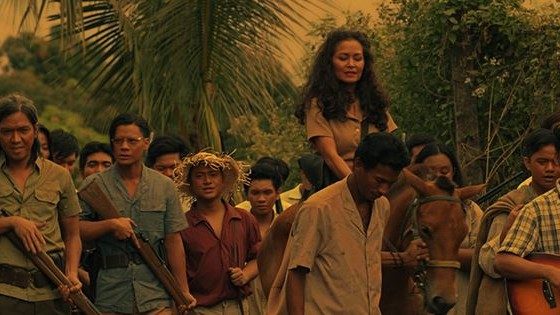SUMMARY
This is AI generated summarization, which may have errors. For context, always refer to the full article.

Carlo Catu’s Aria is a drama set during several decades when the Hukbalahap was formed out of the efforts of the labor movement, which had to evolve because of the invasion of the Japanese.
The film has all the flaws of a low-budgeted period piece.
Pensions and romances
Aria opens with a plea by an elderly woman for the government to restore the pension that is due to former guerilla fighters like her.
From there, the film quietly shifts several decades prior where Pining (Liya Sarmiento), a zarzuela vocalist, is singing in front of an audience composed mostly of town leaders. Local labor leaders, led by David (Jay Garcia), arrive late to see the performance. David becomes smitten with Pining, who has been promised by her ambitious mother to be wed to the mayor’s son.
Daringly, David invites Pining to his cause, which just doesn’t charm Pining but pushes her to adhere to David’s politics and advocacies.
The meat of Aria, where the focus is on Pining and David meeting and separating as the times abruptly change, has the bold sweep of a timeless romance where lovers are torn by the tides of history.
It is however the framing device, where Catu notably infuses the love story with a current and pertinent problem, that turns Aria from simply being a costume drama into a heartfelt and urgent plea for recognition of heroes who are often forgotten because of a skewed understanding of history. Clearly, Catu is more comfortable shaping emotions from contemporary concerns. The passages involving the plight of pensioners struggling through bureaucracy have considerable heft.
Tragic but familiar appeal
Written by Robbie Tantingco with Catu, Aria grounds a very specific advocacy on a love story whose tragic appeal are so familiar, it almost feels derivative of the many other romances relying on historical scope to add novelty to their pleasures.
But it isn’t derivative at all.
The seemingly straightforward love story supplements the echoing of the plight. In navigating the evolution of the guerilla movement that has contributed so much to a nation’s quest for liberation only adds color and a whiff of fervor to an otherwise bleak plea. The film’s most glaring faults arise not from the lack of ambition or creativity but from the limitations afforded by a minuscule budget.
Thankfully, cinematographer Neil Daza understands the constraints of the production and comes up with a look that approximates the mood and feel of the period.
While Catu could have relied on what he is familiar with by focusing on the trials and tribulations of the marginalized elderly as he has so elegantly done in Ari: My Life with a King (2015) and Kung Paano Hinihintay ang Dapithapon (2018), his decision to dive into the past forwards the necessity of telling history from the perspective of the regions.
Aria puts the spotlight on Pampanga, its wealth of heroes, songs, vices and virtues.
Technical faults
The faults of Aria are quite apparent. They glare at the audience. For example, while Sarmiento and Garcia’s performances are fine and sometimes subtly compelling, some scenes would be hampered by leaden portrayals of some of the supporting cast.
However, Catu’s film is rousing when it needs to be rousing. There is certainly more to this than its obvious creases. – Rappler.com

Francis Joseph Cruz litigates for a living and writes about cinema for fun. The first Filipino movie he saw in the theaters was Carlo J. Caparas’ Tirad Pass.
Since then, he’s been on a mission to find better memories with Philippine cinema.
Add a comment
How does this make you feel?
There are no comments yet. Add your comment to start the conversation.